Economics Assignment 2: Impact of Innovation on Business Growth
VerifiedAdded on 2023/04/24
|13
|4297
|281
Homework Assignment
AI Summary
This economics assignment explores the characteristics of successful business leaders like Gary Vaynerchuk, Jeff Bezos, and Tony Robbins. It analyzes the impact of innovation on the growth and profitability of new ventures, covering cost reduction, competitive advantage, and resource allocation. The assignment also examines the relevance of policies designed to improve national innovative capacities, specifically focusing on the Malaysian government's initiatives to foster innovation, including funding for research and development, tax incentives, and the importance of intellectual property rights. The analysis highlights how innovation drives productivity and economic growth, particularly in the manufacturing sector.
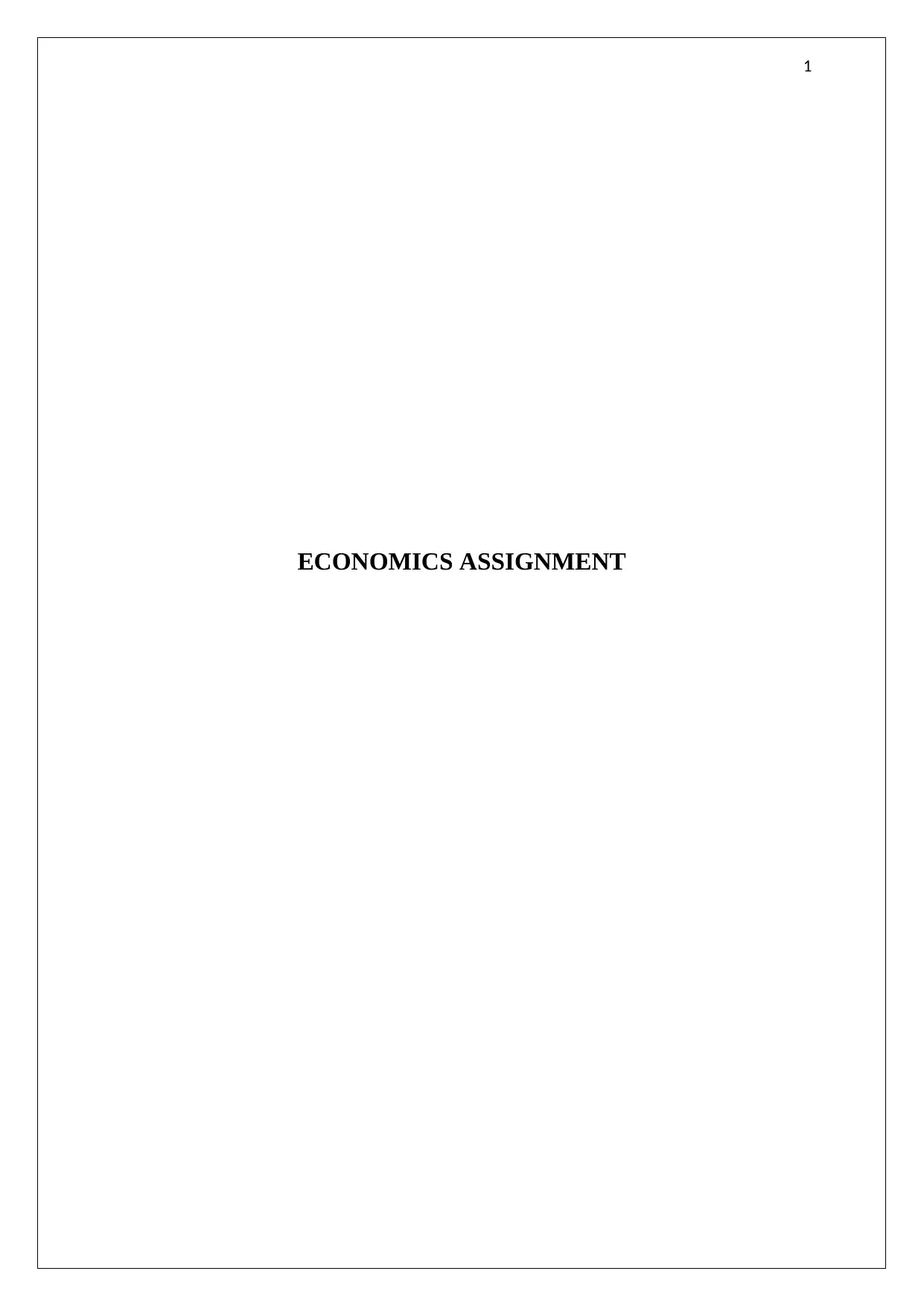
1
ECONOMICS ASSIGNMENT
ECONOMICS ASSIGNMENT
Paraphrase This Document
Need a fresh take? Get an instant paraphrase of this document with our AI Paraphraser

2
Contents
Question one...............................................................................................................................3
Question two..............................................................................................................................6
Reference..................................................................................................................................10
Contents
Question one...............................................................................................................................3
Question two..............................................................................................................................6
Reference..................................................................................................................................10
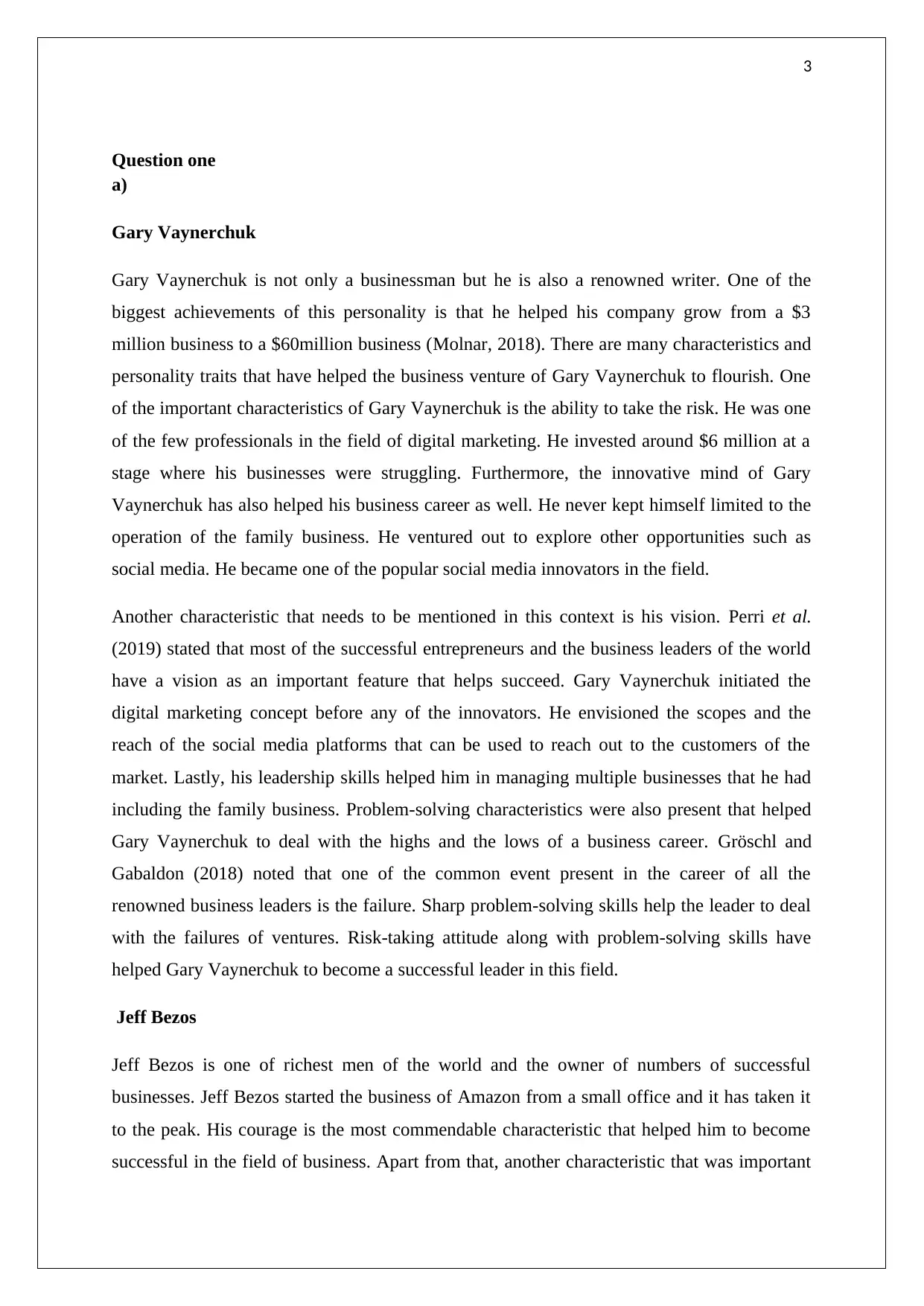
3
Question one
a)
Gary Vaynerchuk
Gary Vaynerchuk is not only a businessman but he is also a renowned writer. One of the
biggest achievements of this personality is that he helped his company grow from a $3
million business to a $60million business (Molnar, 2018). There are many characteristics and
personality traits that have helped the business venture of Gary Vaynerchuk to flourish. One
of the important characteristics of Gary Vaynerchuk is the ability to take the risk. He was one
of the few professionals in the field of digital marketing. He invested around $6 million at a
stage where his businesses were struggling. Furthermore, the innovative mind of Gary
Vaynerchuk has also helped his business career as well. He never kept himself limited to the
operation of the family business. He ventured out to explore other opportunities such as
social media. He became one of the popular social media innovators in the field.
Another characteristic that needs to be mentioned in this context is his vision. Perri et al.
(2019) stated that most of the successful entrepreneurs and the business leaders of the world
have a vision as an important feature that helps succeed. Gary Vaynerchuk initiated the
digital marketing concept before any of the innovators. He envisioned the scopes and the
reach of the social media platforms that can be used to reach out to the customers of the
market. Lastly, his leadership skills helped him in managing multiple businesses that he had
including the family business. Problem-solving characteristics were also present that helped
Gary Vaynerchuk to deal with the highs and the lows of a business career. Gröschl and
Gabaldon (2018) noted that one of the common event present in the career of all the
renowned business leaders is the failure. Sharp problem-solving skills help the leader to deal
with the failures of ventures. Risk-taking attitude along with problem-solving skills have
helped Gary Vaynerchuk to become a successful leader in this field.
Jeff Bezos
Jeff Bezos is one of richest men of the world and the owner of numbers of successful
businesses. Jeff Bezos started the business of Amazon from a small office and it has taken it
to the peak. His courage is the most commendable characteristic that helped him to become
successful in the field of business. Apart from that, another characteristic that was important
Question one
a)
Gary Vaynerchuk
Gary Vaynerchuk is not only a businessman but he is also a renowned writer. One of the
biggest achievements of this personality is that he helped his company grow from a $3
million business to a $60million business (Molnar, 2018). There are many characteristics and
personality traits that have helped the business venture of Gary Vaynerchuk to flourish. One
of the important characteristics of Gary Vaynerchuk is the ability to take the risk. He was one
of the few professionals in the field of digital marketing. He invested around $6 million at a
stage where his businesses were struggling. Furthermore, the innovative mind of Gary
Vaynerchuk has also helped his business career as well. He never kept himself limited to the
operation of the family business. He ventured out to explore other opportunities such as
social media. He became one of the popular social media innovators in the field.
Another characteristic that needs to be mentioned in this context is his vision. Perri et al.
(2019) stated that most of the successful entrepreneurs and the business leaders of the world
have a vision as an important feature that helps succeed. Gary Vaynerchuk initiated the
digital marketing concept before any of the innovators. He envisioned the scopes and the
reach of the social media platforms that can be used to reach out to the customers of the
market. Lastly, his leadership skills helped him in managing multiple businesses that he had
including the family business. Problem-solving characteristics were also present that helped
Gary Vaynerchuk to deal with the highs and the lows of a business career. Gröschl and
Gabaldon (2018) noted that one of the common event present in the career of all the
renowned business leaders is the failure. Sharp problem-solving skills help the leader to deal
with the failures of ventures. Risk-taking attitude along with problem-solving skills have
helped Gary Vaynerchuk to become a successful leader in this field.
Jeff Bezos
Jeff Bezos is one of richest men of the world and the owner of numbers of successful
businesses. Jeff Bezos started the business of Amazon from a small office and it has taken it
to the peak. His courage is the most commendable characteristic that helped him to become
successful in the field of business. Apart from that, another characteristic that was important
⊘ This is a preview!⊘
Do you want full access?
Subscribe today to unlock all pages.

Trusted by 1+ million students worldwide
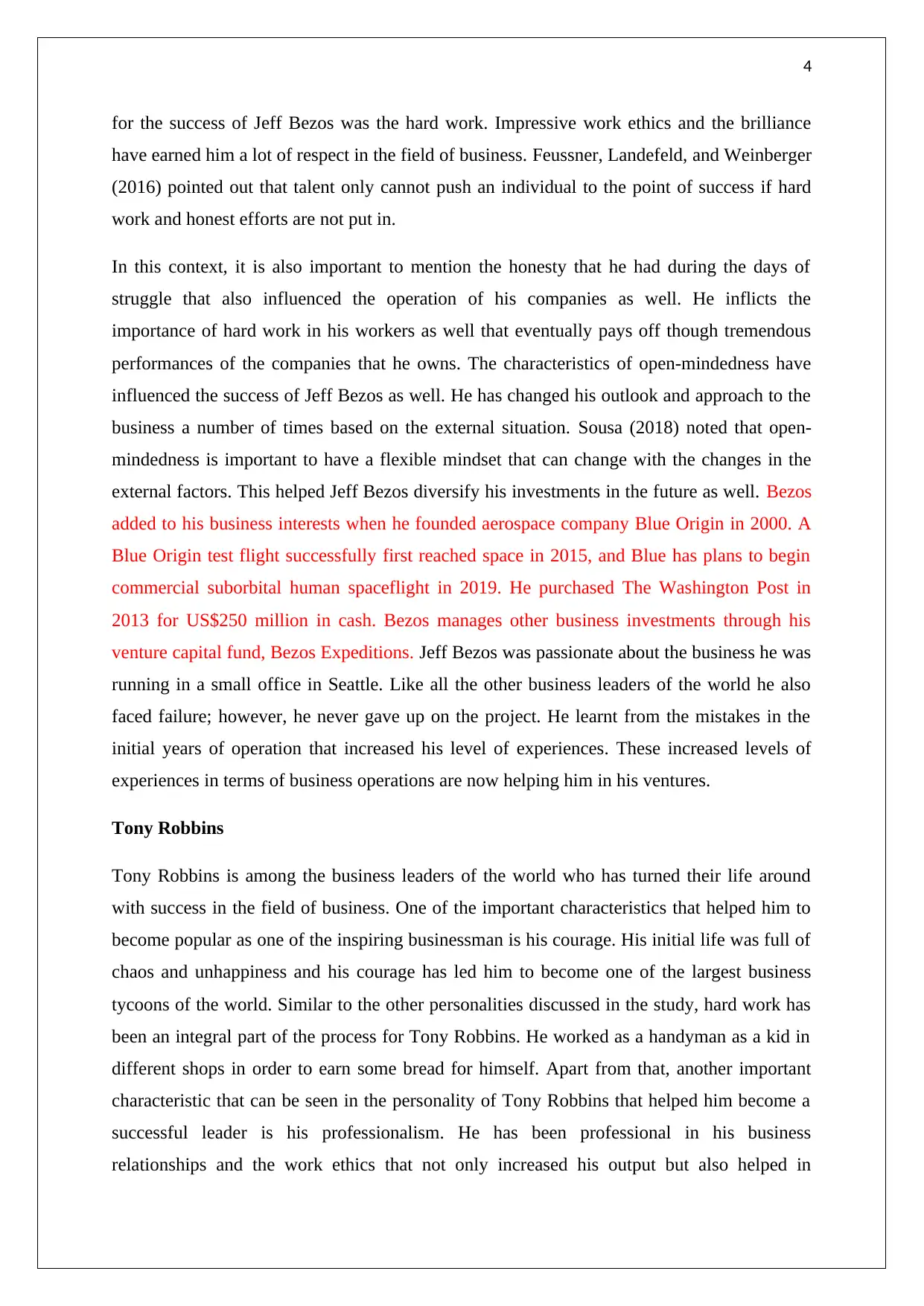
4
for the success of Jeff Bezos was the hard work. Impressive work ethics and the brilliance
have earned him a lot of respect in the field of business. Feussner, Landefeld, and Weinberger
(2016) pointed out that talent only cannot push an individual to the point of success if hard
work and honest efforts are not put in.
In this context, it is also important to mention the honesty that he had during the days of
struggle that also influenced the operation of his companies as well. He inflicts the
importance of hard work in his workers as well that eventually pays off though tremendous
performances of the companies that he owns. The characteristics of open-mindedness have
influenced the success of Jeff Bezos as well. He has changed his outlook and approach to the
business a number of times based on the external situation. Sousa (2018) noted that open-
mindedness is important to have a flexible mindset that can change with the changes in the
external factors. This helped Jeff Bezos diversify his investments in the future as well. Bezos
added to his business interests when he founded aerospace company Blue Origin in 2000. A
Blue Origin test flight successfully first reached space in 2015, and Blue has plans to begin
commercial suborbital human spaceflight in 2019. He purchased The Washington Post in
2013 for US$250 million in cash. Bezos manages other business investments through his
venture capital fund, Bezos Expeditions. Jeff Bezos was passionate about the business he was
running in a small office in Seattle. Like all the other business leaders of the world he also
faced failure; however, he never gave up on the project. He learnt from the mistakes in the
initial years of operation that increased his level of experiences. These increased levels of
experiences in terms of business operations are now helping him in his ventures.
Tony Robbins
Tony Robbins is among the business leaders of the world who has turned their life around
with success in the field of business. One of the important characteristics that helped him to
become popular as one of the inspiring businessman is his courage. His initial life was full of
chaos and unhappiness and his courage has led him to become one of the largest business
tycoons of the world. Similar to the other personalities discussed in the study, hard work has
been an integral part of the process for Tony Robbins. He worked as a handyman as a kid in
different shops in order to earn some bread for himself. Apart from that, another important
characteristic that can be seen in the personality of Tony Robbins that helped him become a
successful leader is his professionalism. He has been professional in his business
relationships and the work ethics that not only increased his output but also helped in
for the success of Jeff Bezos was the hard work. Impressive work ethics and the brilliance
have earned him a lot of respect in the field of business. Feussner, Landefeld, and Weinberger
(2016) pointed out that talent only cannot push an individual to the point of success if hard
work and honest efforts are not put in.
In this context, it is also important to mention the honesty that he had during the days of
struggle that also influenced the operation of his companies as well. He inflicts the
importance of hard work in his workers as well that eventually pays off though tremendous
performances of the companies that he owns. The characteristics of open-mindedness have
influenced the success of Jeff Bezos as well. He has changed his outlook and approach to the
business a number of times based on the external situation. Sousa (2018) noted that open-
mindedness is important to have a flexible mindset that can change with the changes in the
external factors. This helped Jeff Bezos diversify his investments in the future as well. Bezos
added to his business interests when he founded aerospace company Blue Origin in 2000. A
Blue Origin test flight successfully first reached space in 2015, and Blue has plans to begin
commercial suborbital human spaceflight in 2019. He purchased The Washington Post in
2013 for US$250 million in cash. Bezos manages other business investments through his
venture capital fund, Bezos Expeditions. Jeff Bezos was passionate about the business he was
running in a small office in Seattle. Like all the other business leaders of the world he also
faced failure; however, he never gave up on the project. He learnt from the mistakes in the
initial years of operation that increased his level of experiences. These increased levels of
experiences in terms of business operations are now helping him in his ventures.
Tony Robbins
Tony Robbins is among the business leaders of the world who has turned their life around
with success in the field of business. One of the important characteristics that helped him to
become popular as one of the inspiring businessman is his courage. His initial life was full of
chaos and unhappiness and his courage has led him to become one of the largest business
tycoons of the world. Similar to the other personalities discussed in the study, hard work has
been an integral part of the process for Tony Robbins. He worked as a handyman as a kid in
different shops in order to earn some bread for himself. Apart from that, another important
characteristic that can be seen in the personality of Tony Robbins that helped him become a
successful leader is his professionalism. He has been professional in his business
relationships and the work ethics that not only increased his output but also helped in
Paraphrase This Document
Need a fresh take? Get an instant paraphrase of this document with our AI Paraphraser
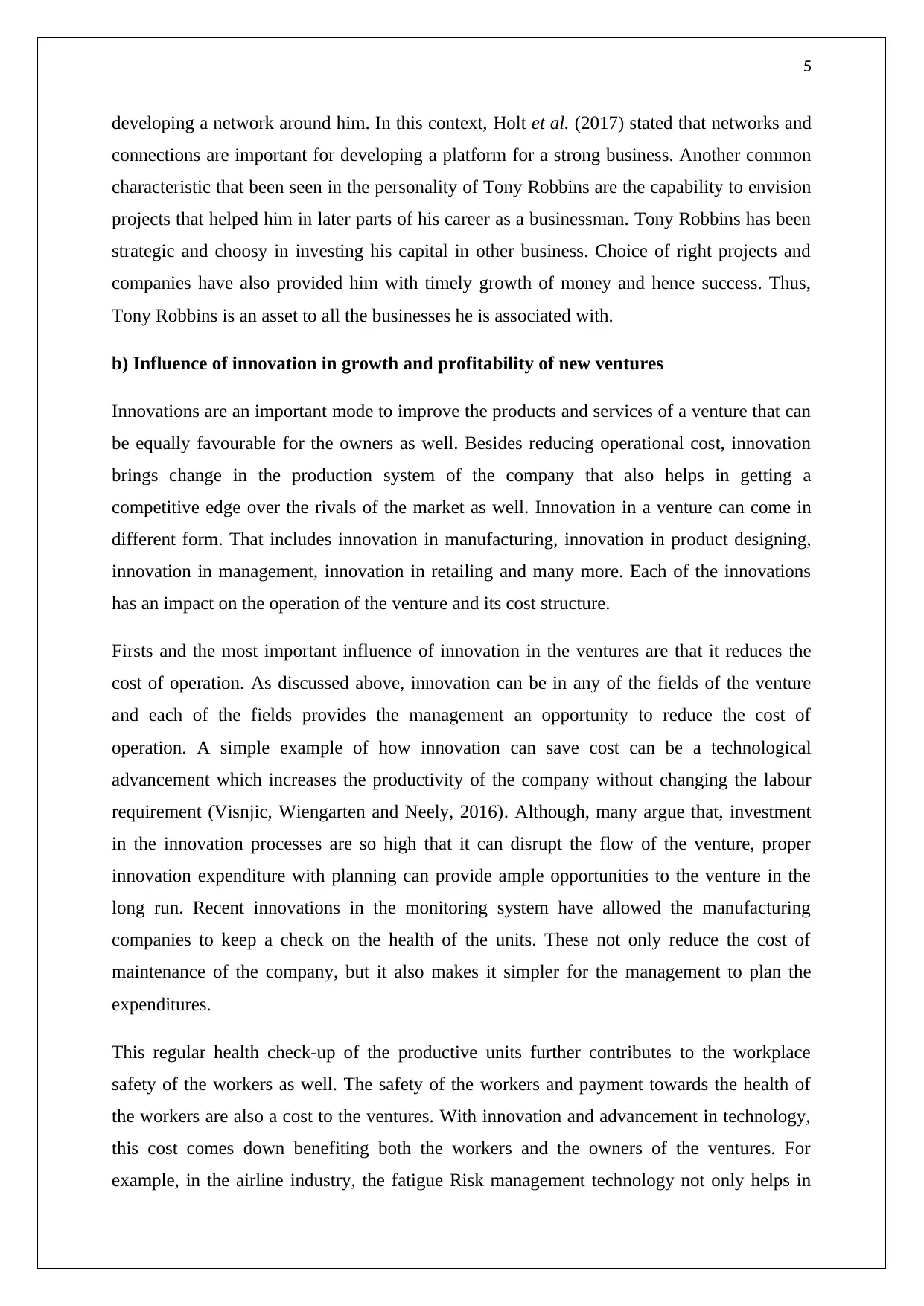
5
developing a network around him. In this context, Holt et al. (2017) stated that networks and
connections are important for developing a platform for a strong business. Another common
characteristic that been seen in the personality of Tony Robbins are the capability to envision
projects that helped him in later parts of his career as a businessman. Tony Robbins has been
strategic and choosy in investing his capital in other business. Choice of right projects and
companies have also provided him with timely growth of money and hence success. Thus,
Tony Robbins is an asset to all the businesses he is associated with.
b) Influence of innovation in growth and profitability of new ventures
Innovations are an important mode to improve the products and services of a venture that can
be equally favourable for the owners as well. Besides reducing operational cost, innovation
brings change in the production system of the company that also helps in getting a
competitive edge over the rivals of the market as well. Innovation in a venture can come in
different form. That includes innovation in manufacturing, innovation in product designing,
innovation in management, innovation in retailing and many more. Each of the innovations
has an impact on the operation of the venture and its cost structure.
Firsts and the most important influence of innovation in the ventures are that it reduces the
cost of operation. As discussed above, innovation can be in any of the fields of the venture
and each of the fields provides the management an opportunity to reduce the cost of
operation. A simple example of how innovation can save cost can be a technological
advancement which increases the productivity of the company without changing the labour
requirement (Visnjic, Wiengarten and Neely, 2016). Although, many argue that, investment
in the innovation processes are so high that it can disrupt the flow of the venture, proper
innovation expenditure with planning can provide ample opportunities to the venture in the
long run. Recent innovations in the monitoring system have allowed the manufacturing
companies to keep a check on the health of the units. These not only reduce the cost of
maintenance of the company, but it also makes it simpler for the management to plan the
expenditures.
This regular health check-up of the productive units further contributes to the workplace
safety of the workers as well. The safety of the workers and payment towards the health of
the workers are also a cost to the ventures. With innovation and advancement in technology,
this cost comes down benefiting both the workers and the owners of the ventures. For
example, in the airline industry, the fatigue Risk management technology not only helps in
developing a network around him. In this context, Holt et al. (2017) stated that networks and
connections are important for developing a platform for a strong business. Another common
characteristic that been seen in the personality of Tony Robbins are the capability to envision
projects that helped him in later parts of his career as a businessman. Tony Robbins has been
strategic and choosy in investing his capital in other business. Choice of right projects and
companies have also provided him with timely growth of money and hence success. Thus,
Tony Robbins is an asset to all the businesses he is associated with.
b) Influence of innovation in growth and profitability of new ventures
Innovations are an important mode to improve the products and services of a venture that can
be equally favourable for the owners as well. Besides reducing operational cost, innovation
brings change in the production system of the company that also helps in getting a
competitive edge over the rivals of the market as well. Innovation in a venture can come in
different form. That includes innovation in manufacturing, innovation in product designing,
innovation in management, innovation in retailing and many more. Each of the innovations
has an impact on the operation of the venture and its cost structure.
Firsts and the most important influence of innovation in the ventures are that it reduces the
cost of operation. As discussed above, innovation can be in any of the fields of the venture
and each of the fields provides the management an opportunity to reduce the cost of
operation. A simple example of how innovation can save cost can be a technological
advancement which increases the productivity of the company without changing the labour
requirement (Visnjic, Wiengarten and Neely, 2016). Although, many argue that, investment
in the innovation processes are so high that it can disrupt the flow of the venture, proper
innovation expenditure with planning can provide ample opportunities to the venture in the
long run. Recent innovations in the monitoring system have allowed the manufacturing
companies to keep a check on the health of the units. These not only reduce the cost of
maintenance of the company, but it also makes it simpler for the management to plan the
expenditures.
This regular health check-up of the productive units further contributes to the workplace
safety of the workers as well. The safety of the workers and payment towards the health of
the workers are also a cost to the ventures. With innovation and advancement in technology,
this cost comes down benefiting both the workers and the owners of the ventures. For
example, in the airline industry, the fatigue Risk management technology not only helps in
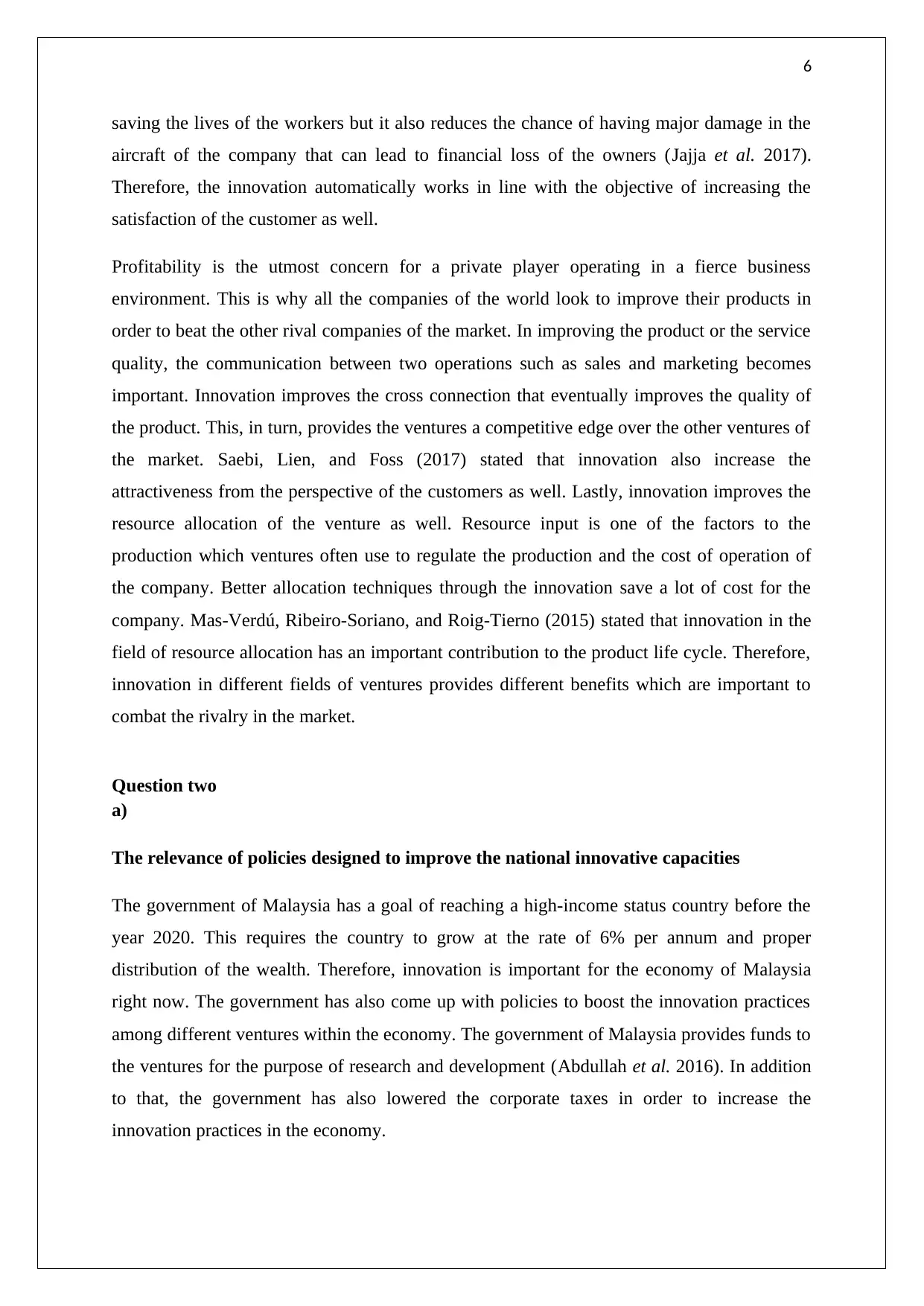
6
saving the lives of the workers but it also reduces the chance of having major damage in the
aircraft of the company that can lead to financial loss of the owners (Jajja et al. 2017).
Therefore, the innovation automatically works in line with the objective of increasing the
satisfaction of the customer as well.
Profitability is the utmost concern for a private player operating in a fierce business
environment. This is why all the companies of the world look to improve their products in
order to beat the other rival companies of the market. In improving the product or the service
quality, the communication between two operations such as sales and marketing becomes
important. Innovation improves the cross connection that eventually improves the quality of
the product. This, in turn, provides the ventures a competitive edge over the other ventures of
the market. Saebi, Lien, and Foss (2017) stated that innovation also increase the
attractiveness from the perspective of the customers as well. Lastly, innovation improves the
resource allocation of the venture as well. Resource input is one of the factors to the
production which ventures often use to regulate the production and the cost of operation of
the company. Better allocation techniques through the innovation save a lot of cost for the
company. Mas-Verdú, Ribeiro-Soriano, and Roig-Tierno (2015) stated that innovation in the
field of resource allocation has an important contribution to the product life cycle. Therefore,
innovation in different fields of ventures provides different benefits which are important to
combat the rivalry in the market.
Question two
a)
The relevance of policies designed to improve the national innovative capacities
The government of Malaysia has a goal of reaching a high-income status country before the
year 2020. This requires the country to grow at the rate of 6% per annum and proper
distribution of the wealth. Therefore, innovation is important for the economy of Malaysia
right now. The government has also come up with policies to boost the innovation practices
among different ventures within the economy. The government of Malaysia provides funds to
the ventures for the purpose of research and development (Abdullah et al. 2016). In addition
to that, the government has also lowered the corporate taxes in order to increase the
innovation practices in the economy.
saving the lives of the workers but it also reduces the chance of having major damage in the
aircraft of the company that can lead to financial loss of the owners (Jajja et al. 2017).
Therefore, the innovation automatically works in line with the objective of increasing the
satisfaction of the customer as well.
Profitability is the utmost concern for a private player operating in a fierce business
environment. This is why all the companies of the world look to improve their products in
order to beat the other rival companies of the market. In improving the product or the service
quality, the communication between two operations such as sales and marketing becomes
important. Innovation improves the cross connection that eventually improves the quality of
the product. This, in turn, provides the ventures a competitive edge over the other ventures of
the market. Saebi, Lien, and Foss (2017) stated that innovation also increase the
attractiveness from the perspective of the customers as well. Lastly, innovation improves the
resource allocation of the venture as well. Resource input is one of the factors to the
production which ventures often use to regulate the production and the cost of operation of
the company. Better allocation techniques through the innovation save a lot of cost for the
company. Mas-Verdú, Ribeiro-Soriano, and Roig-Tierno (2015) stated that innovation in the
field of resource allocation has an important contribution to the product life cycle. Therefore,
innovation in different fields of ventures provides different benefits which are important to
combat the rivalry in the market.
Question two
a)
The relevance of policies designed to improve the national innovative capacities
The government of Malaysia has a goal of reaching a high-income status country before the
year 2020. This requires the country to grow at the rate of 6% per annum and proper
distribution of the wealth. Therefore, innovation is important for the economy of Malaysia
right now. The government has also come up with policies to boost the innovation practices
among different ventures within the economy. The government of Malaysia provides funds to
the ventures for the purpose of research and development (Abdullah et al. 2016). In addition
to that, the government has also lowered the corporate taxes in order to increase the
innovation practices in the economy.
⊘ This is a preview!⊘
Do you want full access?
Subscribe today to unlock all pages.

Trusted by 1+ million students worldwide
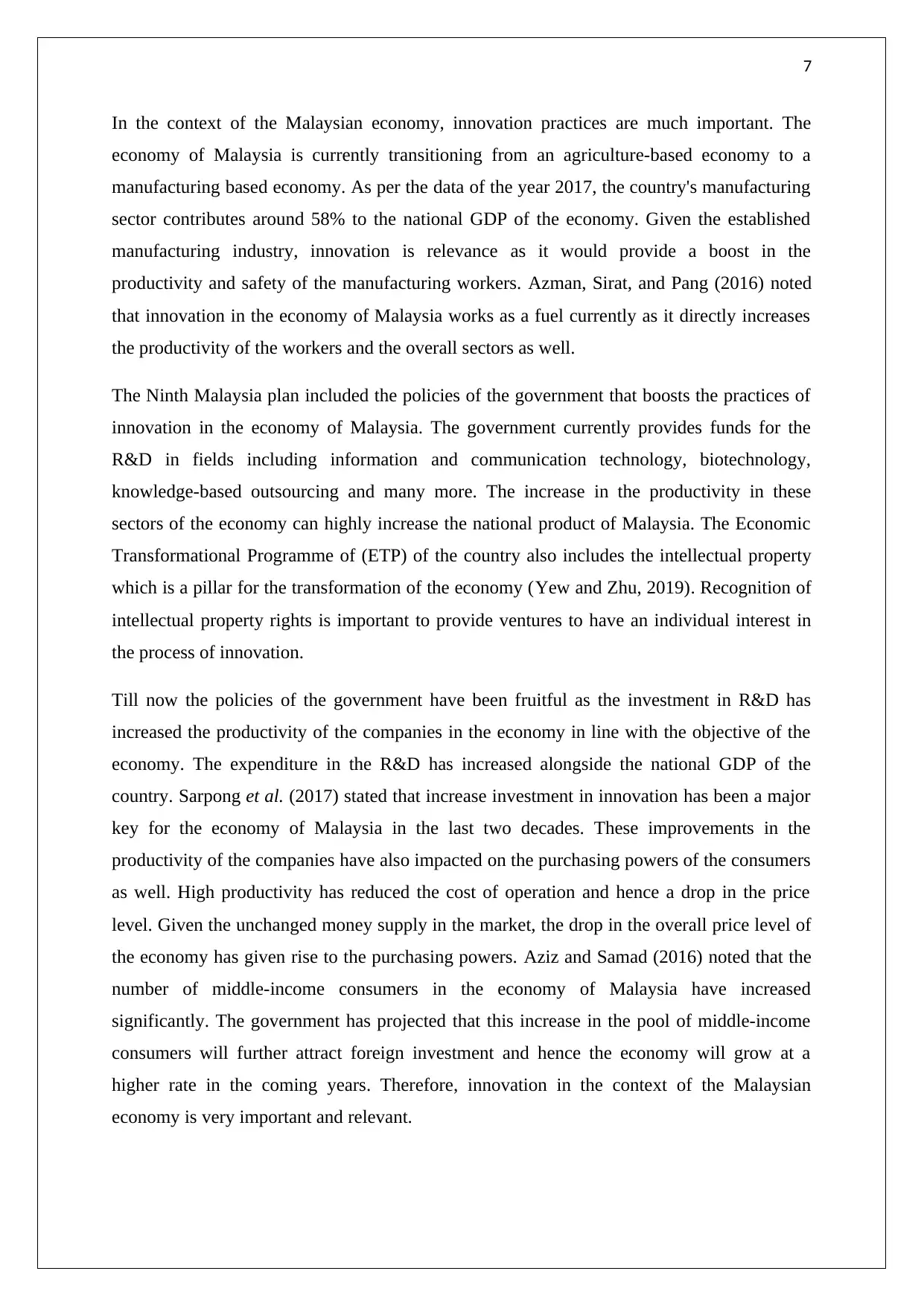
7
In the context of the Malaysian economy, innovation practices are much important. The
economy of Malaysia is currently transitioning from an agriculture-based economy to a
manufacturing based economy. As per the data of the year 2017, the country's manufacturing
sector contributes around 58% to the national GDP of the economy. Given the established
manufacturing industry, innovation is relevance as it would provide a boost in the
productivity and safety of the manufacturing workers. Azman, Sirat, and Pang (2016) noted
that innovation in the economy of Malaysia works as a fuel currently as it directly increases
the productivity of the workers and the overall sectors as well.
The Ninth Malaysia plan included the policies of the government that boosts the practices of
innovation in the economy of Malaysia. The government currently provides funds for the
R&D in fields including information and communication technology, biotechnology,
knowledge-based outsourcing and many more. The increase in the productivity in these
sectors of the economy can highly increase the national product of Malaysia. The Economic
Transformational Programme of (ETP) of the country also includes the intellectual property
which is a pillar for the transformation of the economy (Yew and Zhu, 2019). Recognition of
intellectual property rights is important to provide ventures to have an individual interest in
the process of innovation.
Till now the policies of the government have been fruitful as the investment in R&D has
increased the productivity of the companies in the economy in line with the objective of the
economy. The expenditure in the R&D has increased alongside the national GDP of the
country. Sarpong et al. (2017) stated that increase investment in innovation has been a major
key for the economy of Malaysia in the last two decades. These improvements in the
productivity of the companies have also impacted on the purchasing powers of the consumers
as well. High productivity has reduced the cost of operation and hence a drop in the price
level. Given the unchanged money supply in the market, the drop in the overall price level of
the economy has given rise to the purchasing powers. Aziz and Samad (2016) noted that the
number of middle-income consumers in the economy of Malaysia have increased
significantly. The government has projected that this increase in the pool of middle-income
consumers will further attract foreign investment and hence the economy will grow at a
higher rate in the coming years. Therefore, innovation in the context of the Malaysian
economy is very important and relevant.
In the context of the Malaysian economy, innovation practices are much important. The
economy of Malaysia is currently transitioning from an agriculture-based economy to a
manufacturing based economy. As per the data of the year 2017, the country's manufacturing
sector contributes around 58% to the national GDP of the economy. Given the established
manufacturing industry, innovation is relevance as it would provide a boost in the
productivity and safety of the manufacturing workers. Azman, Sirat, and Pang (2016) noted
that innovation in the economy of Malaysia works as a fuel currently as it directly increases
the productivity of the workers and the overall sectors as well.
The Ninth Malaysia plan included the policies of the government that boosts the practices of
innovation in the economy of Malaysia. The government currently provides funds for the
R&D in fields including information and communication technology, biotechnology,
knowledge-based outsourcing and many more. The increase in the productivity in these
sectors of the economy can highly increase the national product of Malaysia. The Economic
Transformational Programme of (ETP) of the country also includes the intellectual property
which is a pillar for the transformation of the economy (Yew and Zhu, 2019). Recognition of
intellectual property rights is important to provide ventures to have an individual interest in
the process of innovation.
Till now the policies of the government have been fruitful as the investment in R&D has
increased the productivity of the companies in the economy in line with the objective of the
economy. The expenditure in the R&D has increased alongside the national GDP of the
country. Sarpong et al. (2017) stated that increase investment in innovation has been a major
key for the economy of Malaysia in the last two decades. These improvements in the
productivity of the companies have also impacted on the purchasing powers of the consumers
as well. High productivity has reduced the cost of operation and hence a drop in the price
level. Given the unchanged money supply in the market, the drop in the overall price level of
the economy has given rise to the purchasing powers. Aziz and Samad (2016) noted that the
number of middle-income consumers in the economy of Malaysia have increased
significantly. The government has projected that this increase in the pool of middle-income
consumers will further attract foreign investment and hence the economy will grow at a
higher rate in the coming years. Therefore, innovation in the context of the Malaysian
economy is very important and relevant.
Paraphrase This Document
Need a fresh take? Get an instant paraphrase of this document with our AI Paraphraser
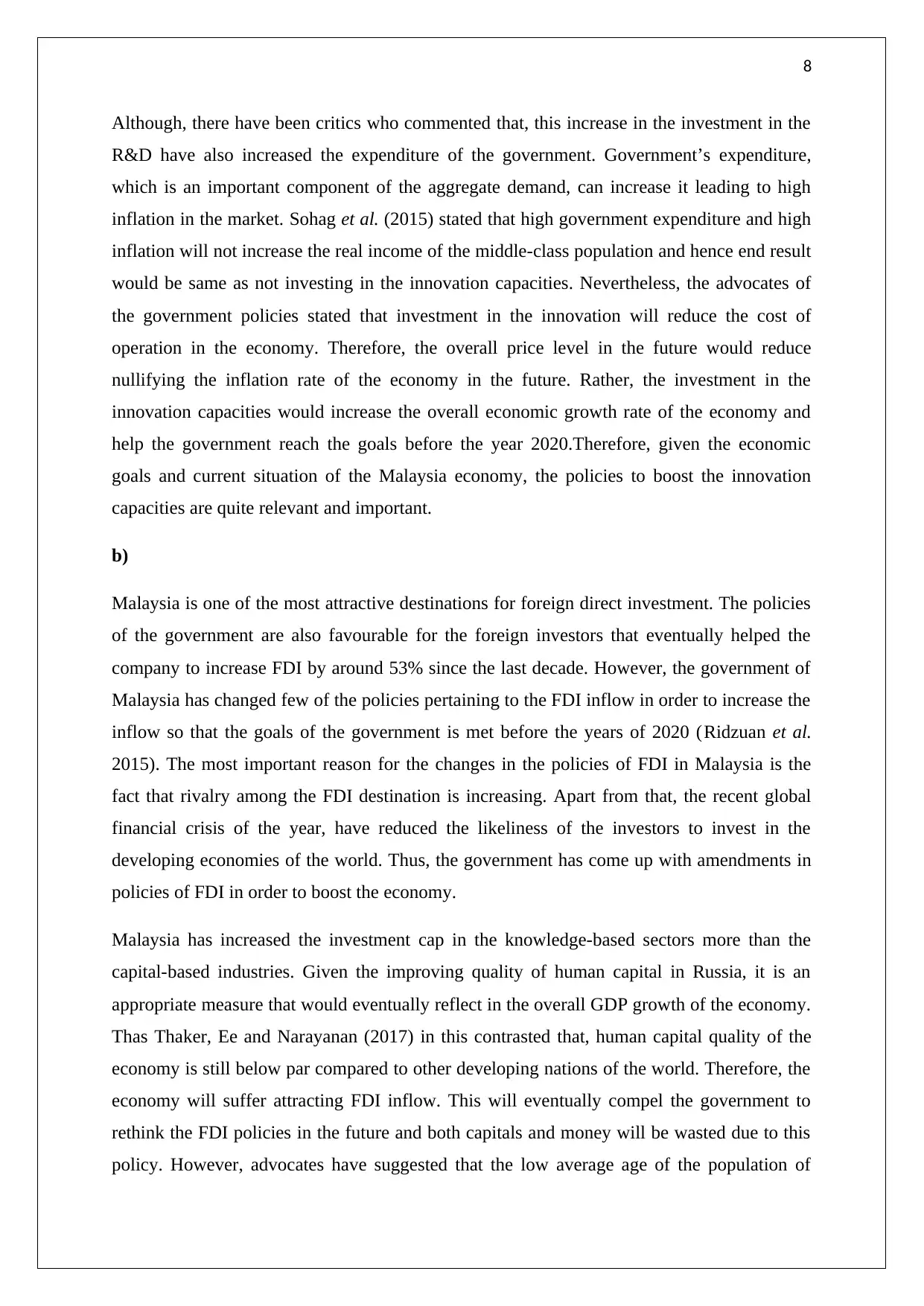
8
Although, there have been critics who commented that, this increase in the investment in the
R&D have also increased the expenditure of the government. Government’s expenditure,
which is an important component of the aggregate demand, can increase it leading to high
inflation in the market. Sohag et al. (2015) stated that high government expenditure and high
inflation will not increase the real income of the middle-class population and hence end result
would be same as not investing in the innovation capacities. Nevertheless, the advocates of
the government policies stated that investment in the innovation will reduce the cost of
operation in the economy. Therefore, the overall price level in the future would reduce
nullifying the inflation rate of the economy in the future. Rather, the investment in the
innovation capacities would increase the overall economic growth rate of the economy and
help the government reach the goals before the year 2020.Therefore, given the economic
goals and current situation of the Malaysia economy, the policies to boost the innovation
capacities are quite relevant and important.
b)
Malaysia is one of the most attractive destinations for foreign direct investment. The policies
of the government are also favourable for the foreign investors that eventually helped the
company to increase FDI by around 53% since the last decade. However, the government of
Malaysia has changed few of the policies pertaining to the FDI inflow in order to increase the
inflow so that the goals of the government is met before the years of 2020 (Ridzuan et al.
2015). The most important reason for the changes in the policies of FDI in Malaysia is the
fact that rivalry among the FDI destination is increasing. Apart from that, the recent global
financial crisis of the year, have reduced the likeliness of the investors to invest in the
developing economies of the world. Thus, the government has come up with amendments in
policies of FDI in order to boost the economy.
Malaysia has increased the investment cap in the knowledge-based sectors more than the
capital-based industries. Given the improving quality of human capital in Russia, it is an
appropriate measure that would eventually reflect in the overall GDP growth of the economy.
Thas Thaker, Ee and Narayanan (2017) in this contrasted that, human capital quality of the
economy is still below par compared to other developing nations of the world. Therefore, the
economy will suffer attracting FDI inflow. This will eventually compel the government to
rethink the FDI policies in the future and both capitals and money will be wasted due to this
policy. However, advocates have suggested that the low average age of the population of
Although, there have been critics who commented that, this increase in the investment in the
R&D have also increased the expenditure of the government. Government’s expenditure,
which is an important component of the aggregate demand, can increase it leading to high
inflation in the market. Sohag et al. (2015) stated that high government expenditure and high
inflation will not increase the real income of the middle-class population and hence end result
would be same as not investing in the innovation capacities. Nevertheless, the advocates of
the government policies stated that investment in the innovation will reduce the cost of
operation in the economy. Therefore, the overall price level in the future would reduce
nullifying the inflation rate of the economy in the future. Rather, the investment in the
innovation capacities would increase the overall economic growth rate of the economy and
help the government reach the goals before the year 2020.Therefore, given the economic
goals and current situation of the Malaysia economy, the policies to boost the innovation
capacities are quite relevant and important.
b)
Malaysia is one of the most attractive destinations for foreign direct investment. The policies
of the government are also favourable for the foreign investors that eventually helped the
company to increase FDI by around 53% since the last decade. However, the government of
Malaysia has changed few of the policies pertaining to the FDI inflow in order to increase the
inflow so that the goals of the government is met before the years of 2020 (Ridzuan et al.
2015). The most important reason for the changes in the policies of FDI in Malaysia is the
fact that rivalry among the FDI destination is increasing. Apart from that, the recent global
financial crisis of the year, have reduced the likeliness of the investors to invest in the
developing economies of the world. Thus, the government has come up with amendments in
policies of FDI in order to boost the economy.
Malaysia has increased the investment cap in the knowledge-based sectors more than the
capital-based industries. Given the improving quality of human capital in Russia, it is an
appropriate measure that would eventually reflect in the overall GDP growth of the economy.
Thas Thaker, Ee and Narayanan (2017) in this contrasted that, human capital quality of the
economy is still below par compared to other developing nations of the world. Therefore, the
economy will suffer attracting FDI inflow. This will eventually compel the government to
rethink the FDI policies in the future and both capitals and money will be wasted due to this
policy. However, advocates have suggested that the low average age of the population of
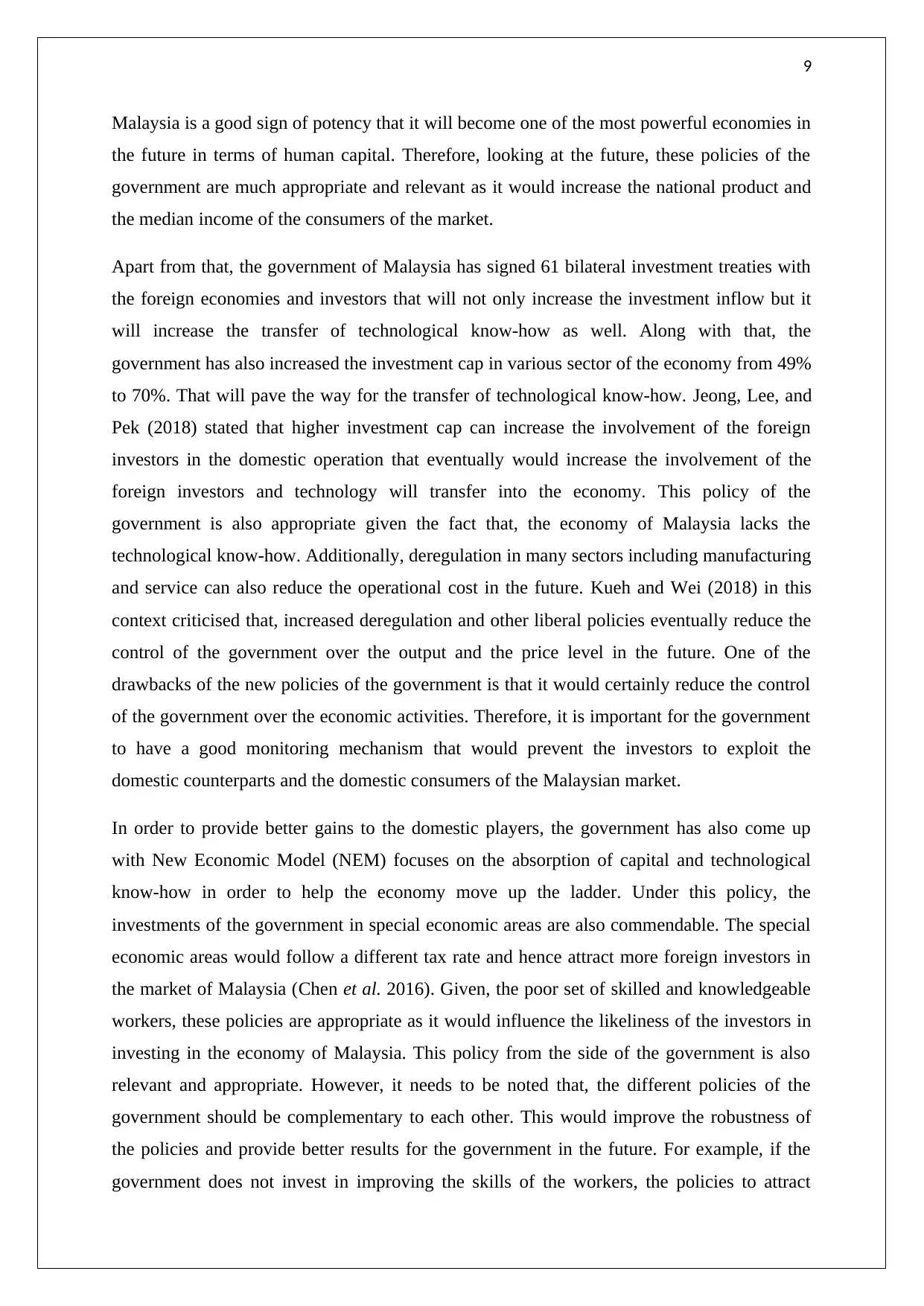
9
Malaysia is a good sign of potency that it will become one of the most powerful economies in
the future in terms of human capital. Therefore, looking at the future, these policies of the
government are much appropriate and relevant as it would increase the national product and
the median income of the consumers of the market.
Apart from that, the government of Malaysia has signed 61 bilateral investment treaties with
the foreign economies and investors that will not only increase the investment inflow but it
will increase the transfer of technological know-how as well. Along with that, the
government has also increased the investment cap in various sector of the economy from 49%
to 70%. That will pave the way for the transfer of technological know-how. Jeong, Lee, and
Pek (2018) stated that higher investment cap can increase the involvement of the foreign
investors in the domestic operation that eventually would increase the involvement of the
foreign investors and technology will transfer into the economy. This policy of the
government is also appropriate given the fact that, the economy of Malaysia lacks the
technological know-how. Additionally, deregulation in many sectors including manufacturing
and service can also reduce the operational cost in the future. Kueh and Wei (2018) in this
context criticised that, increased deregulation and other liberal policies eventually reduce the
control of the government over the output and the price level in the future. One of the
drawbacks of the new policies of the government is that it would certainly reduce the control
of the government over the economic activities. Therefore, it is important for the government
to have a good monitoring mechanism that would prevent the investors to exploit the
domestic counterparts and the domestic consumers of the Malaysian market.
In order to provide better gains to the domestic players, the government has also come up
with New Economic Model (NEM) focuses on the absorption of capital and technological
know-how in order to help the economy move up the ladder. Under this policy, the
investments of the government in special economic areas are also commendable. The special
economic areas would follow a different tax rate and hence attract more foreign investors in
the market of Malaysia (Chen et al. 2016). Given, the poor set of skilled and knowledgeable
workers, these policies are appropriate as it would influence the likeliness of the investors in
investing in the economy of Malaysia. This policy from the side of the government is also
relevant and appropriate. However, it needs to be noted that, the different policies of the
government should be complementary to each other. This would improve the robustness of
the policies and provide better results for the government in the future. For example, if the
government does not invest in improving the skills of the workers, the policies to attract
Malaysia is a good sign of potency that it will become one of the most powerful economies in
the future in terms of human capital. Therefore, looking at the future, these policies of the
government are much appropriate and relevant as it would increase the national product and
the median income of the consumers of the market.
Apart from that, the government of Malaysia has signed 61 bilateral investment treaties with
the foreign economies and investors that will not only increase the investment inflow but it
will increase the transfer of technological know-how as well. Along with that, the
government has also increased the investment cap in various sector of the economy from 49%
to 70%. That will pave the way for the transfer of technological know-how. Jeong, Lee, and
Pek (2018) stated that higher investment cap can increase the involvement of the foreign
investors in the domestic operation that eventually would increase the involvement of the
foreign investors and technology will transfer into the economy. This policy of the
government is also appropriate given the fact that, the economy of Malaysia lacks the
technological know-how. Additionally, deregulation in many sectors including manufacturing
and service can also reduce the operational cost in the future. Kueh and Wei (2018) in this
context criticised that, increased deregulation and other liberal policies eventually reduce the
control of the government over the output and the price level in the future. One of the
drawbacks of the new policies of the government is that it would certainly reduce the control
of the government over the economic activities. Therefore, it is important for the government
to have a good monitoring mechanism that would prevent the investors to exploit the
domestic counterparts and the domestic consumers of the Malaysian market.
In order to provide better gains to the domestic players, the government has also come up
with New Economic Model (NEM) focuses on the absorption of capital and technological
know-how in order to help the economy move up the ladder. Under this policy, the
investments of the government in special economic areas are also commendable. The special
economic areas would follow a different tax rate and hence attract more foreign investors in
the market of Malaysia (Chen et al. 2016). Given, the poor set of skilled and knowledgeable
workers, these policies are appropriate as it would influence the likeliness of the investors in
investing in the economy of Malaysia. This policy from the side of the government is also
relevant and appropriate. However, it needs to be noted that, the different policies of the
government should be complementary to each other. This would improve the robustness of
the policies and provide better results for the government in the future. For example, if the
government does not invest in improving the skills of the workers, the policies to attract
⊘ This is a preview!⊘
Do you want full access?
Subscribe today to unlock all pages.

Trusted by 1+ million students worldwide

10
investment would fail as it would find it hard to source the labours (Fadhil and Almsafir,
2015). Therefore, the goal of the government should also be to support one policy with the
other in order to make it fruitful for the future goals of the government.
investment would fail as it would find it hard to source the labours (Fadhil and Almsafir,
2015). Therefore, the goal of the government should also be to support one policy with the
other in order to make it fruitful for the future goals of the government.
Paraphrase This Document
Need a fresh take? Get an instant paraphrase of this document with our AI Paraphraser
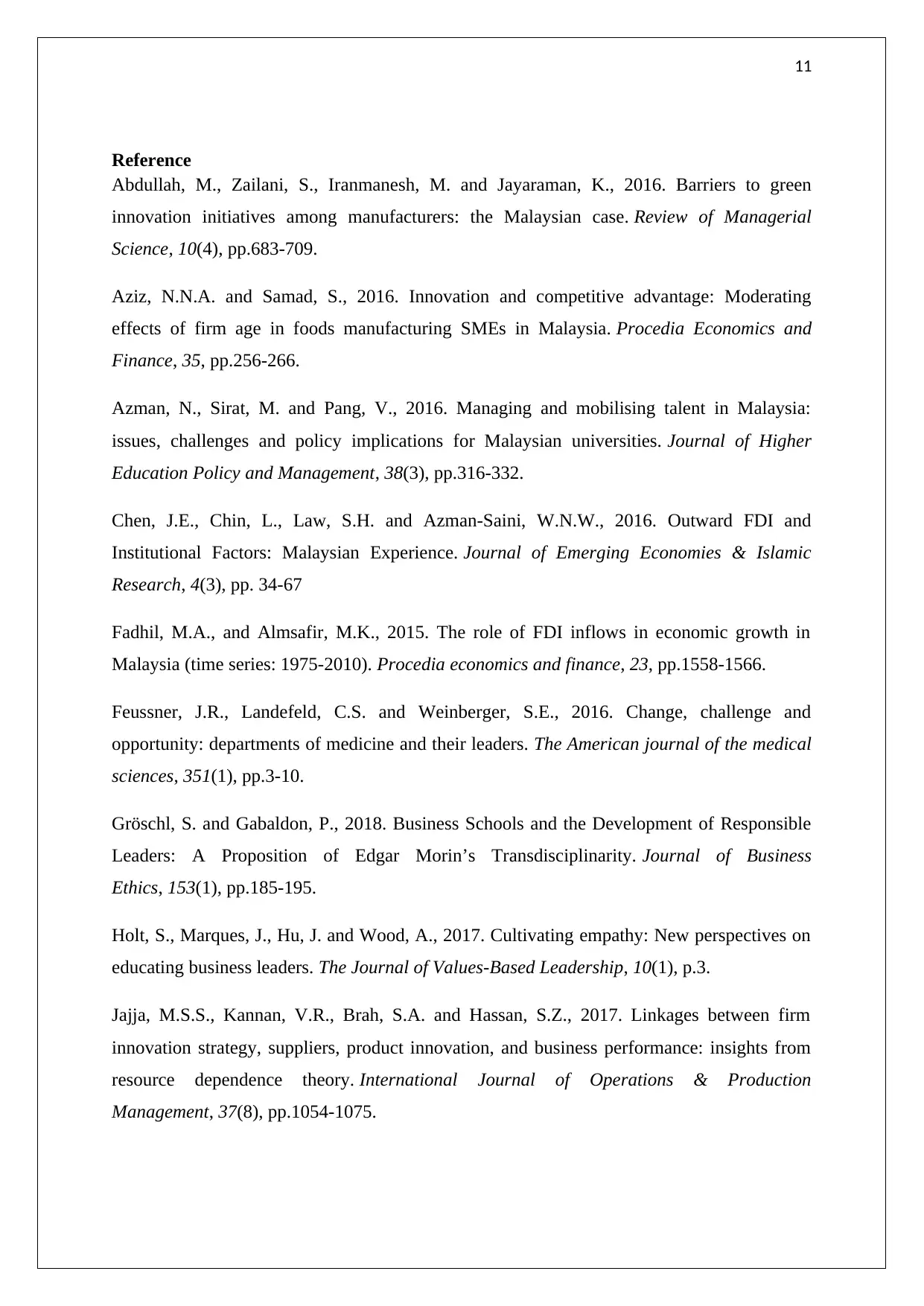
11
Reference
Abdullah, M., Zailani, S., Iranmanesh, M. and Jayaraman, K., 2016. Barriers to green
innovation initiatives among manufacturers: the Malaysian case. Review of Managerial
Science, 10(4), pp.683-709.
Aziz, N.N.A. and Samad, S., 2016. Innovation and competitive advantage: Moderating
effects of firm age in foods manufacturing SMEs in Malaysia. Procedia Economics and
Finance, 35, pp.256-266.
Azman, N., Sirat, M. and Pang, V., 2016. Managing and mobilising talent in Malaysia:
issues, challenges and policy implications for Malaysian universities. Journal of Higher
Education Policy and Management, 38(3), pp.316-332.
Chen, J.E., Chin, L., Law, S.H. and Azman-Saini, W.N.W., 2016. Outward FDI and
Institutional Factors: Malaysian Experience. Journal of Emerging Economies & Islamic
Research, 4(3), pp. 34-67
Fadhil, M.A., and Almsafir, M.K., 2015. The role of FDI inflows in economic growth in
Malaysia (time series: 1975-2010). Procedia economics and finance, 23, pp.1558-1566.
Feussner, J.R., Landefeld, C.S. and Weinberger, S.E., 2016. Change, challenge and
opportunity: departments of medicine and their leaders. The American journal of the medical
sciences, 351(1), pp.3-10.
Gröschl, S. and Gabaldon, P., 2018. Business Schools and the Development of Responsible
Leaders: A Proposition of Edgar Morin’s Transdisciplinarity. Journal of Business
Ethics, 153(1), pp.185-195.
Holt, S., Marques, J., Hu, J. and Wood, A., 2017. Cultivating empathy: New perspectives on
educating business leaders. The Journal of Values-Based Leadership, 10(1), p.3.
Jajja, M.S.S., Kannan, V.R., Brah, S.A. and Hassan, S.Z., 2017. Linkages between firm
innovation strategy, suppliers, product innovation, and business performance: insights from
resource dependence theory. International Journal of Operations & Production
Management, 37(8), pp.1054-1075.
Reference
Abdullah, M., Zailani, S., Iranmanesh, M. and Jayaraman, K., 2016. Barriers to green
innovation initiatives among manufacturers: the Malaysian case. Review of Managerial
Science, 10(4), pp.683-709.
Aziz, N.N.A. and Samad, S., 2016. Innovation and competitive advantage: Moderating
effects of firm age in foods manufacturing SMEs in Malaysia. Procedia Economics and
Finance, 35, pp.256-266.
Azman, N., Sirat, M. and Pang, V., 2016. Managing and mobilising talent in Malaysia:
issues, challenges and policy implications for Malaysian universities. Journal of Higher
Education Policy and Management, 38(3), pp.316-332.
Chen, J.E., Chin, L., Law, S.H. and Azman-Saini, W.N.W., 2016. Outward FDI and
Institutional Factors: Malaysian Experience. Journal of Emerging Economies & Islamic
Research, 4(3), pp. 34-67
Fadhil, M.A., and Almsafir, M.K., 2015. The role of FDI inflows in economic growth in
Malaysia (time series: 1975-2010). Procedia economics and finance, 23, pp.1558-1566.
Feussner, J.R., Landefeld, C.S. and Weinberger, S.E., 2016. Change, challenge and
opportunity: departments of medicine and their leaders. The American journal of the medical
sciences, 351(1), pp.3-10.
Gröschl, S. and Gabaldon, P., 2018. Business Schools and the Development of Responsible
Leaders: A Proposition of Edgar Morin’s Transdisciplinarity. Journal of Business
Ethics, 153(1), pp.185-195.
Holt, S., Marques, J., Hu, J. and Wood, A., 2017. Cultivating empathy: New perspectives on
educating business leaders. The Journal of Values-Based Leadership, 10(1), p.3.
Jajja, M.S.S., Kannan, V.R., Brah, S.A. and Hassan, S.Z., 2017. Linkages between firm
innovation strategy, suppliers, product innovation, and business performance: insights from
resource dependence theory. International Journal of Operations & Production
Management, 37(8), pp.1054-1075.
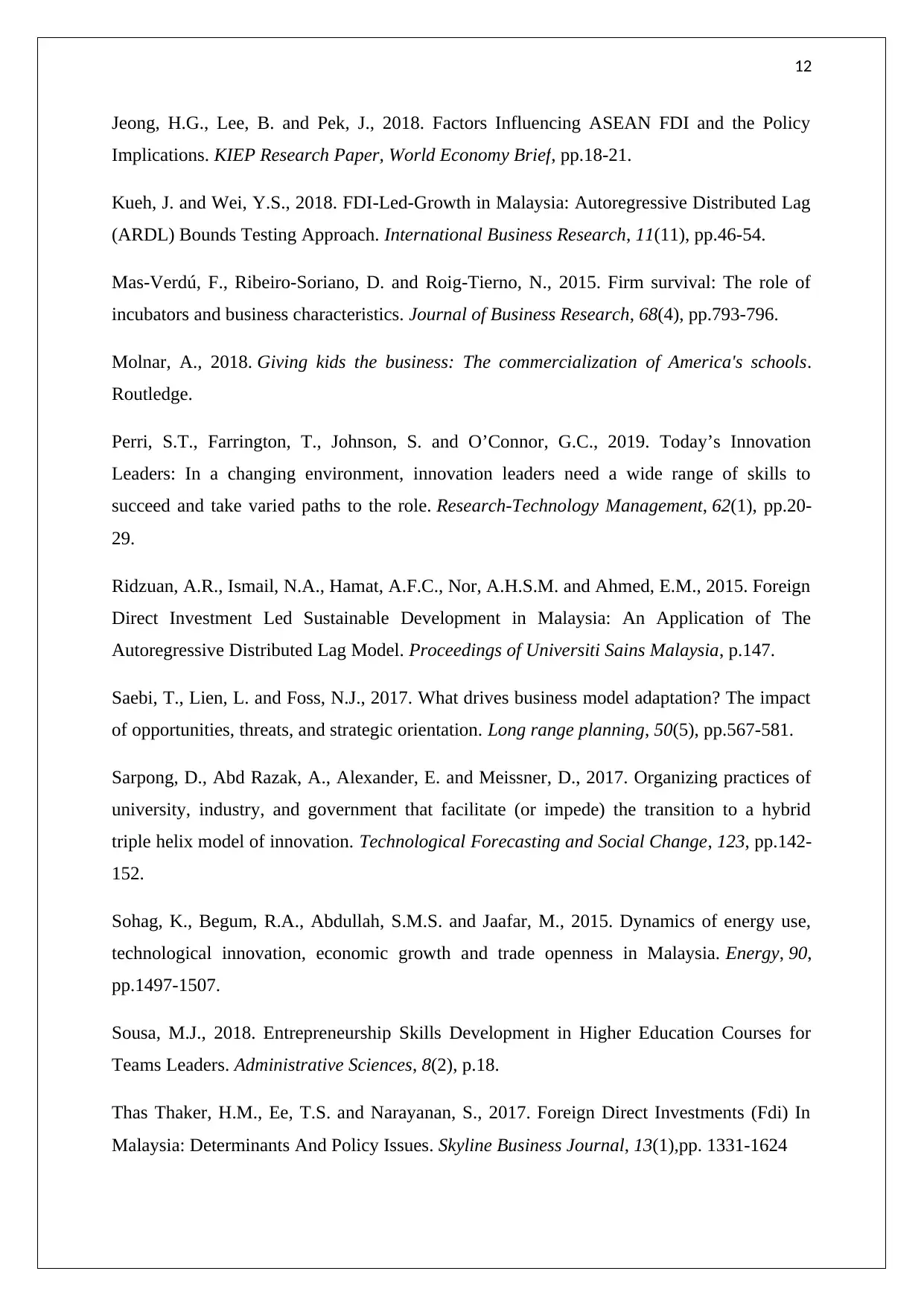
12
Jeong, H.G., Lee, B. and Pek, J., 2018. Factors Influencing ASEAN FDI and the Policy
Implications. KIEP Research Paper, World Economy Brief, pp.18-21.
Kueh, J. and Wei, Y.S., 2018. FDI-Led-Growth in Malaysia: Autoregressive Distributed Lag
(ARDL) Bounds Testing Approach. International Business Research, 11(11), pp.46-54.
Mas-Verdú, F., Ribeiro-Soriano, D. and Roig-Tierno, N., 2015. Firm survival: The role of
incubators and business characteristics. Journal of Business Research, 68(4), pp.793-796.
Molnar, A., 2018. Giving kids the business: The commercialization of America's schools.
Routledge.
Perri, S.T., Farrington, T., Johnson, S. and O’Connor, G.C., 2019. Today’s Innovation
Leaders: In a changing environment, innovation leaders need a wide range of skills to
succeed and take varied paths to the role. Research-Technology Management, 62(1), pp.20-
29.
Ridzuan, A.R., Ismail, N.A., Hamat, A.F.C., Nor, A.H.S.M. and Ahmed, E.M., 2015. Foreign
Direct Investment Led Sustainable Development in Malaysia: An Application of The
Autoregressive Distributed Lag Model. Proceedings of Universiti Sains Malaysia, p.147.
Saebi, T., Lien, L. and Foss, N.J., 2017. What drives business model adaptation? The impact
of opportunities, threats, and strategic orientation. Long range planning, 50(5), pp.567-581.
Sarpong, D., Abd Razak, A., Alexander, E. and Meissner, D., 2017. Organizing practices of
university, industry, and government that facilitate (or impede) the transition to a hybrid
triple helix model of innovation. Technological Forecasting and Social Change, 123, pp.142-
152.
Sohag, K., Begum, R.A., Abdullah, S.M.S. and Jaafar, M., 2015. Dynamics of energy use,
technological innovation, economic growth and trade openness in Malaysia. Energy, 90,
pp.1497-1507.
Sousa, M.J., 2018. Entrepreneurship Skills Development in Higher Education Courses for
Teams Leaders. Administrative Sciences, 8(2), p.18.
Thas Thaker, H.M., Ee, T.S. and Narayanan, S., 2017. Foreign Direct Investments (Fdi) In
Malaysia: Determinants And Policy Issues. Skyline Business Journal, 13(1),pp. 1331-1624
Jeong, H.G., Lee, B. and Pek, J., 2018. Factors Influencing ASEAN FDI and the Policy
Implications. KIEP Research Paper, World Economy Brief, pp.18-21.
Kueh, J. and Wei, Y.S., 2018. FDI-Led-Growth in Malaysia: Autoregressive Distributed Lag
(ARDL) Bounds Testing Approach. International Business Research, 11(11), pp.46-54.
Mas-Verdú, F., Ribeiro-Soriano, D. and Roig-Tierno, N., 2015. Firm survival: The role of
incubators and business characteristics. Journal of Business Research, 68(4), pp.793-796.
Molnar, A., 2018. Giving kids the business: The commercialization of America's schools.
Routledge.
Perri, S.T., Farrington, T., Johnson, S. and O’Connor, G.C., 2019. Today’s Innovation
Leaders: In a changing environment, innovation leaders need a wide range of skills to
succeed and take varied paths to the role. Research-Technology Management, 62(1), pp.20-
29.
Ridzuan, A.R., Ismail, N.A., Hamat, A.F.C., Nor, A.H.S.M. and Ahmed, E.M., 2015. Foreign
Direct Investment Led Sustainable Development in Malaysia: An Application of The
Autoregressive Distributed Lag Model. Proceedings of Universiti Sains Malaysia, p.147.
Saebi, T., Lien, L. and Foss, N.J., 2017. What drives business model adaptation? The impact
of opportunities, threats, and strategic orientation. Long range planning, 50(5), pp.567-581.
Sarpong, D., Abd Razak, A., Alexander, E. and Meissner, D., 2017. Organizing practices of
university, industry, and government that facilitate (or impede) the transition to a hybrid
triple helix model of innovation. Technological Forecasting and Social Change, 123, pp.142-
152.
Sohag, K., Begum, R.A., Abdullah, S.M.S. and Jaafar, M., 2015. Dynamics of energy use,
technological innovation, economic growth and trade openness in Malaysia. Energy, 90,
pp.1497-1507.
Sousa, M.J., 2018. Entrepreneurship Skills Development in Higher Education Courses for
Teams Leaders. Administrative Sciences, 8(2), p.18.
Thas Thaker, H.M., Ee, T.S. and Narayanan, S., 2017. Foreign Direct Investments (Fdi) In
Malaysia: Determinants And Policy Issues. Skyline Business Journal, 13(1),pp. 1331-1624
⊘ This is a preview!⊘
Do you want full access?
Subscribe today to unlock all pages.

Trusted by 1+ million students worldwide
1 out of 13
Related Documents
Your All-in-One AI-Powered Toolkit for Academic Success.
+13062052269
info@desklib.com
Available 24*7 on WhatsApp / Email
![[object Object]](/_next/static/media/star-bottom.7253800d.svg)
Unlock your academic potential
Copyright © 2020–2025 A2Z Services. All Rights Reserved. Developed and managed by ZUCOL.




